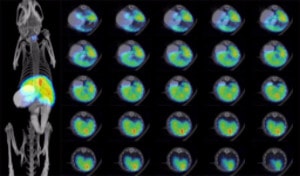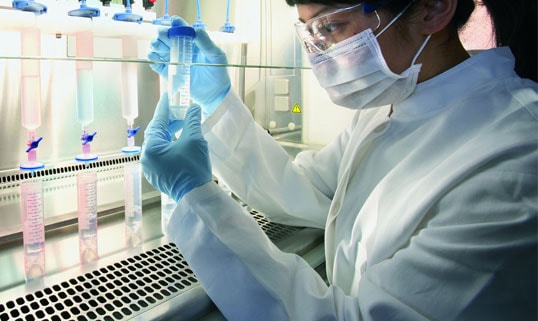CT26.WT-mNIS-Neo/eGFP-Puro
- Frozen / Standard (CL045-STAN) $ 2,100
Species: Mouse
Cell type: Colorectal Cancer
Transgenes: Murine sodium iodide symporter (mNIS) with neomycin resistance (Neo) for selection with G418 and enhanced green fluorescent protein (eGFP) with puromycin resistance (Puro) for selection with puromycin
Media: DMEM, 10% FBS, 1% Pen/Strep, 0.4mg/mL G418, 3μg/mL puromycin
Description: CT26.WT-mNIS-Neo/eGFP-Puro is a polyclonal population of the murine colorectal carcinoma cell line CT26.WT (ATCC® CRL-2638™) transduced with 1) LV-mNIS-P2A-Neo (LV025) encoding the murine sodium iodide symporter (mNIS) cDNA under the spleen focus-forming virus (SFFV) promoter linked to the neomycin resistance gene (Neo) via a P2A cleavage peptide and 2) LV-eGFP-PGK-Puro (LV031) encoding enhanced green fluorescent protein (eGFP) cDNA under the spleen focus-forming virus (SFFV) promoter and the puromycin resistance gene (Puro) under control of the PGK promoter.
The lentiviral vector used is a self-inactivating (SIN) vector in which the viral enhancer and promoter has been deleted. Transcription inactivation of the LTR in the SIN provirus increases biosafety by preventing mobilization by replication competent viruses and enables regulated expression of the genes from the internal promoters without cis-acting effects of the LTR (Miyoshi et al., J Virol. 1998).
Cell Line Authentication: Authentication of the parental CT26.WT cell line was performed by short tandem repeat (STR) profiling with 27 STR loci. STR profiling of CT26.WT cells are verified and there is no interspecies cross contamination detected.
Recommended uses:
In vitro: This is a high mNIS/eGFP expressing cell line suitable for use as a positive control cell line in iodine uptake assays and fluorescence assays to verify NIS or GFP expression respectively in your lentiviral transduced cells.
In vivo: CT26.WT cells form tumors post implantation into syngenic Balb/c mice. The in vivo growth of these metastases can be monitored using noninvasive, high-resolution 3D PET/SPECT imaging or optical imaging for GFP fluorescence.
Note: In-life imaging for GFP fluorescence is not recommended due to high background autofluorescence. Tissues may be harvested post mortem for analysis by conventional microscopy. For in vivo imaging, please use the nonimmunogenic murine NIS reporter gene or firefly luciferase.
References on NIS imaging:
1. Fruthwirth et al. A whole body dual modality radionuclide optical strategy for preclinical imaging of metastasis and heterogeneous treatment responses in different. microenvironments. J. Nucl. Med 2014. 55(4): 686-94.
2. Penheiter et al. The sodium iodide symporter (NIS) as an imaging reporter for gene, viral and cell-based therapies. Curr Gene Ther. 2012, 12(1):33-47.
Morphology: Low- and high-density cell morphology (200x)

NIS Function Assay (Iodine Uptake): Cells were incubated with 125I for 1h in the presence or absence of KClO4, an inhibitor of iodine uptake. Radioiodine concentrated within the cells was measured with a gamma counter.

Flow cytometry of CT26.WT-mNIS-Neo/GFP-Puro (green) and control (gray) cells.

Publications that used associated reagents:
LV-eGFP-PGK-Puro (LV031): Shen et al. Immunovirotherapy with vesicular stomatitis virus and PD-L1 blockade enhances therapeutic outcome in murine acute myeloid leukemia. Blood. 2016. March 17: 127(11): 1449-58.

